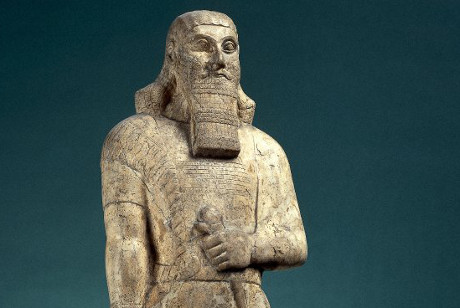You are seeing an unstyled version of this site. If this is because you are using an older web browser, we recommend that you upgrade to a modern, standards-compliant browser such as FireFox [http://www.getfirefox.com/], which is available free of charge for Windows, Mac and Linux.

From the last quarter of the third millennium BC to the last decade of the middle seventh century BC, Assyria (lit. 'the land of [the god] Aššur') rose from a small, yet important trading center to be the largest, most powerful empire in the Middle East in antiquity. Assyria reached its apex under king Ashurbanipal (668–ca. 631 BC), the grandson of Sennacherib (704–681 BC). However, about twenty years after his death, this once-great empire ceased to exist as a political entity; its most important cities, including the administrative capital Nineveh and the religious center Ashur, lay abandoned and desolate, destroyed by the Babylonians and Medes. During the course of its long history, over 110 men ruled over Assyria, whose heartland roughly comprises modern-day northern Iraq.
Most, if not all, of Assyria's rulers, the earliest of whom called themselves 'vice-regent of (the god) Aššur' — like their southern Akkadian, Sumerian, and Babylonian counterparts — had (numerous) inscriptions officially commissioned in their names. These royal texts ("Assyrian Royal Inscriptions") were generally written in the first person and frequently boasted about one or more of the achievements of their royal patrons, primarily for the purpose of divine recognition and for posterity. In addition to describing military campaigns and hunting expeditions (lions or elephants), many Assyrian inscriptions describe the construction or renovation of monumental buildings (temples, palaces, walls, etc.) and include frequent allusions to religious matters (e.g., the New Year's festival). Sometimes, these inscriptions were written to simply indicate that an object belonged to them.
Over 1,900 Akkadian and Sumerian royal inscriptions written in the names of Assyria's rulers, prominent members of their families, and their officials survive today. Those texts are preserved on several thousand clay, metal, and stone objects. The majority of these are assumed to have been unearthed in the ruins of the three main cities of Assyria: Ashur, Calah, and Nineveh. Many of the bricks, clay cylinders, clay prisms, clay tablets, paving stones, foundation blocks, beads, etc. discovered through (scientific) archaeological excavations or illicit digs have made their way into numerous museum and private collections around the world. Some objects, especially those that were too heavy to haul back to Europe or North America, were left and buried in the field by their excavators after their contents were recorded, copied, and/or photographed.
Following in the footsteps of the now-defunct Royal Inscriptions of Mesopotamia (RIM) Project (directed by A. Kirk Grayson; University of Toronto) and in cooperation with the NEH-funded Royal Inscriptions of the Neo-Assyrian Period (RINAP) Project [http://oracc.museum.upenn.edu/rinap/] (directed by Grant Frame, University of Pennsylvania [2008–23]), the aim of RIAo, a sub-project of the Official Inscriptions of the Middle East in Antiquity (OIMEA) Project, is to publish in a single place easily accessible and annotated (lemmatized) editions of all of the known Akkadian (and Sumerian) royal inscriptions from Assyria (and Babylonia when it was under Assyrian domination) that were composed from the end of the third millennium BC to 612 BC.
Starting in 2022, under the direction of Karen Radner [https://www.en.ag.geschichte.uni-muenchen.de/staff/staff/radner/index.html] and Grant Frame [https://upenn.academia.edu/GrantFrame], the Royal Inscriptions of Assyria [https://www.en.ag.geschichte.uni-muenchen.de/chairs/chair_radner/research_radner/royal_inscript_assyria/index.html] (RIA) publication project was formerly established. This new publication project —whose printed volumes will be published by Eisenbrauns [https://www.eisenbrauns.org], an imprint of Penn State University Press [https://www.psupress.org] — aims to provide updated editions of the complete corpus of Akkadian inscriptions of the Assyrian rulers from the late third millennium BC to the reign of Aššur-narari V (754–745 BC). In essence, the publications of the Royal Inscriptions of Assyria (RIA) series will serve as "second editions" of the three authoritative volumes prepared by A. Kirk Grayson (1987–96) for the Assyrian Periods sub-series of the University-of-Toronto-based Royal Inscriptions of Mesopotamia (RIM) series, which was published by University of Toronto Press [https://utorontopress.com]: Assyrian Rulers of the Third and Second Millennia BC (to 1115 BC) (1987), Assyrian Rulers of the Early First Millennium BC I (1114–859 BC) (1991), and Assyrian Rulers of the Early First Millennium BC II (858–745 BC) (1996) (= RIMA 1–3). Work on The Royal Inscriptions of Assyria, Part 4: Ashurnasirpal II (883–859 BC) (by A. Kirk Grayson and J. Caleb Howard, with the assistance of Jamie Novotny) is already underway; revised translations of the "RIA 4" texts (by Novotny) are presently accessible via the RIA 4 corpus [/riao/ria4/corpus], as well as in the main RIAo corpus [/riao/corpus]. For further details, see the "About the Project" page.
RIA has received funding from
- the Alexander von Humboldt Foundation [https://www.humboldt-foundation.de] (through the establishment of the Chair for the Ancient History of the Near and Middle East in 2015; until 2020);
- Ludwig-Maximilians-Universität München, especially through the Cambridge LMU Strategic Partnership [https://www.cambridge.uni-muenchen.de/index.html] (from 2019); and
- the Deutsche Forschungsgemeinschaft (through the award of a Gottfried Wilhelm Leibnitz Prize [https://www2.daad.de/der-daad/daad-aktuell/de/82434-leibniz-preis-fuer-daad-alumna-professorin-karen-radner-im-portraet/] in 2022).
